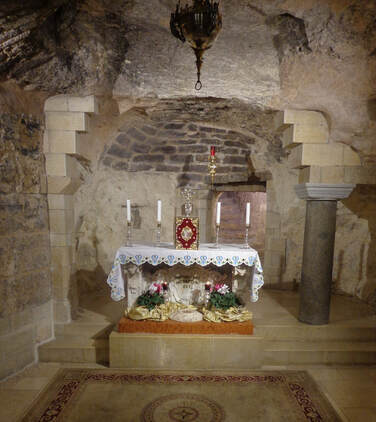|
Read: Luke 1:26-38 (www.biblestudytools.com/nrs/luke/1.html)
Sing: To a Maid Engaged to Joseph, UMH 215 The limestone caves in and around Nazareth have been used by humans for thousands of years. People have used the caves as a place of shelter for themselves, their families, and their domesticated animals. People used the caves as storage space for their belongings, their crops, and the water they collected. People have used the caves of Nazareth as places to do work and business. A cave attached to your home allowed you have additional space you did not have to pay for or build. Caves were also a form of security: when everything you built could be knocked down, burned down, or swept away the caves remained. So it is not surprising to discover that the home of Anne and Joachim, the parents of Mary, was joined to a cave and that Mary was in that cave when the Archangel Gabriel appeared to her and announced that she would give birth to the Son of God. The Church of the Annunciation is built over that cave. Located in the downtown area of Nazareth this large church is surrounded by a beautiful courtyard decorated by artwork from around the world and is topped by a large cupola and revolving lantern which functions much like a lighthouse (Jesus is the light of the world who will draw all people to himself). The main worship area, used by the local Catholic community, is above the cave/grotto and has an octagonal opening in its floor in front of the altar which exposes the grotto below with the cupola above. On the grotto level a worship area is built in front of the cave which is surrounded by the remains of earlier churches. The first church was built on this site around 427. This was followed by a Crusader church that was destroyed in 1187. The Franciscans built a church in 1740, which was razed to build the present Basilica. Prior to the modern construction extensive excavations were carried out. These excavations revealed remains of the ancient village of Nazareth with its silos, cisterns, and other cave-dwellings. The most sensational discovery was of a shrine or synagogue-church dating back to before the first church was built. Scratched on the base of a column appeared the Greek characters XE-MAPIA, translated as “Hail Mary” – the Archangel Gabriel’s greeting to Mary. This is a special place. The architecture and the artwork are extremely complimentary to the main feature – Mary’s cave. Mary was probably only 14 years old when she was confronted with this startling revelation. And yet she had the maturity to respond in a way that we too often refuse to do: “I will do whatever God wants me to do.” God help us!
0 Comments
Leave a Reply. |
AuthorIn matters of faith, we at First United Methodist Church, Sealy put primary reliance on the Bible. In scripture, we understand that we are all God’s children; therefore, we will be a church that cares for the needs of our church and local community through prayer, deeds, inspiration, and love in the spirit of Christ. Archives
July 2020
Categories |
Location |
Our MissionCaring for the needs of our church and community through prayer, deeds, inspiration and love in the Spirit of Christ.
Sunday Worship: 10 am Adult & Children & Youth Sunday School 9 am First Kids Mother's Day Out (Tuesday & Thursday; 8am to 2pm; Ages 1-3) Rev Pat Bell, Pastor First United Methodist Church Sealy
200 Atchison Street Sealy, Texas 77474 979.885.2223 |
Contact Us |

 RSS Feed
RSS Feed